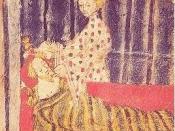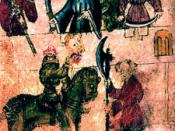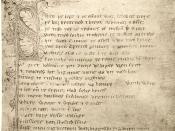In medieval times, purity and virtue were much-admired traits. Evil was hated by all, and looked lowly upon by all members of society. In "Sir Gawain and the Green Knight" and "The Canterbury Tales" the respective authors tell of how evil, although believed to be a trait of low beggars and such, could creep its way into the higher rungs of society, and through certain circumstances, force all kinds of people to selfish acts of greed.
Sir Gawain the glorious is the epitome of good, and all that chivalry stands for. He is very attracted to the lady of the castle, who has cheeks of "red and white, lovely to behold, and small smiling lips." She walks into his room as he is asleep, and points out that they are alone, the men are out hunting, and the servants in their beds, and tells him that he is "welcome to [her] company."
She bestows praise on him with much gusto, telling him that "[she] has [Sir Gawain] which [all women] desire." She continues, saying that if she was fortunate enough to have "the wealth of the world in her hand, and might choose a lord to her liking, then ... there should be no knight on earth to be chosen before [him]!" Yet, even after she, "the brightest of maidens" made as though she loved him, Sir Gawain turned her away, resisting temptation to commit adultery, a grave sin; confirming his chivalric duties.
Nevertheless, Gawain is not perfect and when the time comes for him to fulfill his half of the covenant, he is petrified. Yet, his sense of duty convinces him to continue, and "he [proffers], with good grace / his bare neck to the blade, / and [feigns] a cheerful face: / scorned to seem afraid."...



Loved the essay
this essay was well writen loved reading it hope to see more in the future
6 out of 6 people found this comment useful.